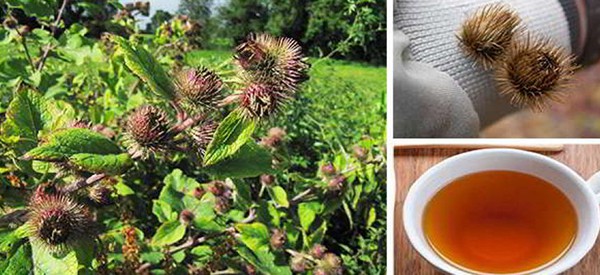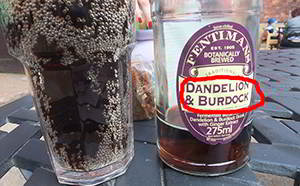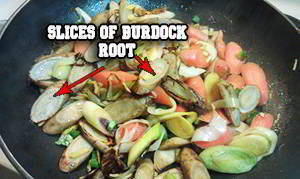
Burdock: The Annoying Weed That Can Save Your Life
If you’ve ever walked through the edges of woodland, passing by tall leafy plants, then looked at your clothes and seen sticky burrs attached, you can bet you’ve just walked pass some burdock. Burdock is a tall plant; it can grow to 4 feet and has purple flowers that blossom in the summer months. Those sticky burrs were the inspiration for Velcro and if you get them on you, you’ll know why.
The best way to deal with this annoying weed?
Eat it!
Burdock is infinitely edible, that is both the plant and the root can be eaten. As a child one of my favorite soft drinks was “dandelion and burdock”. The drink was a horrible brown color, but it tasted great. Burdock is one of those multi-use plants, it is eaten both as a food and used as a medicine.
The uses of burdock as a food and medicine stretch back hundreds of years. For example, Europeans used the plant as an herbal medicine, which we will explore more later on, using original texts. The Chinese and Indians used the plant for a number of complaints including colds and flu. Native Indians in North America would use the plant to treat rheumatism and Shaker communities used it for gout, syphilis and leprosy.
There are other uses for the plant too. The Chinese used burdock for skin complaints such as acne and eczema. There was also a controversial case involving burdock in 50s America. A doctor called Harry Hoxsey had created a number of cancer treatments. The treatments used secret formulas and often contained wild flowers and plants. Hoxsey had a case brought against him by the FDA because of not fully labeling his treatments for cancer, one of which included burdock root. Interestingly, research has continued since then into the use of burdock as a cancer treatment. There’s some interesting further reading here at the University of Maryland Medical Center.
Some Old Times Advise on the Use of Burdock
I am a big fan of lost wisdom. Just because knowledge is from the past, doesn’t mean to say it isn’t still of use. Many of our modern medicines have been derived from the accumulated knowledge of our ancestors. Probably the most famous being aspirin, which was used, in its naturally occurring form of salicin found in willow bark, by ancient Egyptians, who used it for aches and pains.
A quick look through ‘New Dispensatory’, a book of medicinal recipes from 1765, finds a number of uses for arctium or bardanae majoris, the common names for burdock back in the day. It describes burdock as (translated from the original):
“The seeds have a bitterish, subacrid taste. They are recommended as very efficacious diuretics…”
The chapter goes on to describe the taste of burdock root, as
“The roots taste sweetish, with a sight austerity and bitterishness: they are esteemed aperient, diuretic and sudorific”
Medicinal Recipes:
1. From the New Dispensatory 1765: Decoction of Burdock
“Take of Burdock roots, two ounces;Vitriolated tartar, one dram;Water, three pints. Boil the water with the roots, so long that the liquor, when strained, may amount only to a quart; to which add the vitriolated tartar.This decoction is drank to the quantity of one pint per day, as a mild aperient, diuretic and sweetener, for scorbutic and rheumatic complaints.”
For a modern take on the above recipe, substitute ‘vitriolated tartar’ for ‘cream of tartar’ and 1 dram is around 1/8 of a fluid ounce. I’d dissolve a couple of teaspoons of cream of tartar in a small amount of water to get your ‘vitriolated tartar’.
2. Burdock Coffee for Dysentery
The seeds of burdock can be ground and infused like coffee. ‘Burdock Coffee’ is good for dysentery.
3. Decoction of Burdock
You can also create a decoction of Burdock to be used in a similar manner as Burdock Coffee. Decoction’s of burdock are used to treat rheumatism and gout.
To create a decoction you should follow these steps:
- Mash up burdock root
- Boil the mash in water for about 10 minutes
- Strain
- Drink the resultant liquid the dosage being 2 fluid ounces 3-4 times per day
Notes: Sudorific means to cause sweating.
Diuretic makes you pass urine.
Edible Burdock: Some Burdock Recipes for Eating and Drinking
Burdock, especially the root, is a perfect ingredient for all sorts of dishes. However, it is the young burdock that tastes best. For burdock recipes you are best using a first year plant, as after this the burdock is less palatable.
1. Burdock Root Stir Fry
Burdock root forms the basis of this quick and easy recipe:
- A handful of burdock roots
- Handful of other root vegetable such as carrot or parsnip
- Onion or shallot
- Broccoli
- Spinach leaves
- Nuts
- Salt, or spices, such as cayenne pepper, or if available soy sauce
- Finely chopped meat or prawns (optional)
Indications:
- Take your burdock root. Top and tail and peel it as you would a carrot.
- Thinly slice the burdock root and any other root you’re using, lengthways.
- Slice all other ingredients thinly, including any meats
- Add some oil or other grease to a shallow pan
- Heat the oil until it is very hot and spread around the pan
- Place all ingredients in the pan and cook really quickly, the trick to good stir fry is a hot and fast cooking method
You can add a scrambled egg to the stir fry too, once served
2. Burdock Fries
Burdock is lovely roasted as fries in the oven. Top, tail and peel the burdock root. Then slice into fries and place in the oven with oil and salt and cook for about 15 minutes at 450F.
3. Burdock Mash
Top, tail and peel the burdock root. Take some potatoes and prepare them for boiling. Cut the burdock root up as finely as you can. Roast the burdock root and boil the potatoes. Mash the two together with butter and/or milk and a little parsley. Add salt and pepper to taste.
4. And finally, Dandelion and Burdock ‘Pop’ (D&B)
My favorite. Nothing reminds me of childhood as much as this sweet soft drink. This drink is a little like a root beer and somewhat like sarsaparilla. It is an old drink, dating back to the 13th century in England. I doubt that version of D&B would have been anything like my childhood drink. The recipe here is a more modern, sweet version, but you can leave the sweetness out if you prefer, or substitute sugar for honey.
 Dandelion & Burdock – also commercially available
Dandelion & Burdock – also commercially available
Ingredients
- Dandelion root – several roots, ground up
- Burdock root – 2 large roots, ground up
- Vanilla – either pod (1/2) or essence (1 tsp)
- pinch of cinnamon or all spice
- 1 lemon or lime
- 300g sugar
- 1 pint of water
Indications:
- Make sure the roots are clean.
- Chop the roots up as finely as you can and place them in a pan with the water.
- Add the vanilla pod/essence, cinnamon and lemon juice to the pan
- Boil for about 20 minutes.
- Strain the liquid, removing the roots into a container
- While still warm, add the sugar and stir till dissolved
- You will now have a cordial to dilute to taste
Serve with soda or still water!
10 Beautiful Plants That Are Secretly Killing Your Garden
10 Things Cowboys Carried With Them in the Wild West to Survive (Video)
The Only Plant That Should Be in Your First Aid Kit
Potassium Permanganate: Why You Need It in Your Survival Kit?



Excellent information. As a fourth generation nutritionist and both my mother and grandmother herbalists, I know this information is accurate.
Hi Charmene,
Thank you so much for your feedback. We really appreciate it.
So glad you like the article.
God bless!
I just learned about the goodness of burdock a couple of years ago and have learned to like the taste of raw young burdock root. Where I am you can only get it from the Korean grocery store. I peel, slice and add it into all kinds of vegetable soup, everyone eats it!
Hi Nita,
Thank you for your comment. I wasn’t aware that you can purchase raw young burdock root from the Korean grocery store!
This is a great tip!
God bless!
I was surprised to learn of these uses of burdock in the West. I’ve lived in Japan for a number of years, and I enjoyed eating burdock root in a number of delicious ways. When I was in college, a professor of modern Japanese history shared with us tales of American POWs mistakenly believing that their Japanese captors were trying to feed them inedible tree branches when in fact they were being given burdock root.
Hi Joe,
Thank you for sharing this with us. We really appreciate it.
God bless!
My horses find most of the burdock plants in our pasture. So good to know there’s a real purpose besides giving my horses unruly hairdos!
Hi Jennifer,
Thank you for your lovely comment.
So you don’t have to pick it anymore, because the horses deliver it to you.
God bless!
Burdock root for Cancer is true. I have tried it on 6 family members & friends that all have had great reports back from the CA Drs.
Mind you it is mixed with 6 other ingredients.
I would love to hear the 6 other ingredients if you are able to share and don’t mind. This is so fascinating to me. Nature and our bodies are amazing.
Essiac Tea has the Burdock root and additional ingredients
Essiac is right but it needs to be put together properly. Burdock root, slippery elm bark, sheep sorrel herb, golden thread, Turkish rhubarb root, red clover, water cress, & perry winkle
can you give measurements of the other ingrediants, my husband had to have one lung removed due to cancer in lower lobe of his lung, I would greatly appreciate it.
Appreciate your help for all.
Hi Daniel,
Thank you so much for your lovely words.
God bless!
I LOVE getting these emails as well as the Book and ebook. This about Burdock reminds me how I used it 40 years ago to fight an office flu which flattened all but me ! 🙂
Hi Dianne,
Thank you so much for your comment. I am glad you find our articles useful.
God bless!
How to use burdock root for eczema?
Hi Biased,
Thank you so much for your kind words! We really appreciate it.
God bless!
Hi Regina,
Thank you for your question. Here is a great article which explains how to make a burdock root cream for eczema:
https://oureczema.com/burdock-root-for-eczema/
God bless!
A friend identified a plant in my yard as yellow dock. The root was very invasive and large. Is this the same as burdock? We cut up the roots which were very tough and put in grain alcohol. I have 2 pint jars that have sat for a little over two years but am hesitant to use it and was not sure how to take it or if it would be safe.
Hi Meryl,
Thank you so much for your comment.
Yellow dock is thought to benefit the digestive tract, liver, and skin and to treat inflamed nasal passages. One of its primary uses by herbalists is for skin conditions associated with poor digestion, poor liver function or “toxicity.”
However, be aware! Before using yellow dock or any other herb, contact a local herbalist who can guide you.
God bless!
Thank You for the information and advice. I recently purchased your book., The Lost Remedies and will see if I can find my answer there. I love this blog!
How do I grind up the roots?
Grind in a blender or in a mortar
Thank you so much for your words of wisdom. I think I’m going to enjoy this beverage with my granddaughter.
Thank you Very mach, for the updates on your amazing herbs
For a sugar free drink version , I would use stevia as a sweetener which I find works well with citrus or sour(like hibiscus) I am recovering from cancer and am on a low glycemic diet since sugar feeds cancer. In fact, Nicole, could you maybe include options for sugar free and gluten free vegans? So many old recipes include dairy or animal products or alcohol, it would be great if you could mention alcohol alternatives. Thank you, great work!
I just learned the the Friends of the Urban Forest are no longer planting Liquidamber here – not because of
the (sort of) spiky seed balls, but because they release volatile organic compounds (VOCs) into the atmosphere.
Who knew?
Thank you! Where is the DIY guide mentioned above? I wasn’t able to find it.
Hi, Nicole, I was reading your book, and on the section on parasites, there was no mention of Ginger. In his book “The Green Pharmacy” Dr. Burk stated that when eating Sushi, you should always be sure to eat the pickled Ginger. Raw fish contains a parasite called Anasarkas, or spelled something like that, any way, Ginger not only kills the parasite, it also kills the eggs. I had an indoor, out door cat, down in Florida, and she had worms. Her hair was dull, and her eyes had matter in them. I also could see the worms in her balloon knot (rectum) I asked my vet, if there was any harm to giving my cat ginger. She said that she knew of none. So, I put three or four sprinkles on her food, stirred it up and surprise, she ate it without any hesitancy. I did this every day, for about a week. Her hair was shiny again, and no matter in her eyes, and no little critters waving from her balloon knot. So once a week I would sprinkle the store bought powdered ginger on her food, and mix it up, and there was no more problems with parasites. I was surprised that she ate it, but she did. I think fresh ground, or juice would probably have been too strong for her. Also on the article about Devils Club, you stated that the berries were poisonous to humans, and to leave them for the animals that can tolerate them. Yet in the paragraph before that, you stated that the berries could be mashed up, and rubbed in the scalp for preventing dandruff. If they are poisonous, I don’t want to be massaging them into my scalp. Also, Milk Thistle is supposed to be the hands down best for liver problems. I don’t have any Milk Thistle here on my property, that I know of, Not sure how to recognize it, but I have more Canadian Thistle, than I want! Are other thistles good for the liver also? I have a lot of wild herbs growing all over my property, St. John’s Wort, Mullein, Stinging Nettle, Cat Nip, Morrels, and various small tree berries, Like service berries. I have Black Birch, and probably a bunch of other stuff I don’t know of. I live in NW Montana, and there are Huckle Berries, thimble berries, Devil’s Club, Ox eye daisy, Comfrey, Cotton Wood trees, Which I collect the bark for carving, (Fouse as medicine do you have to coect bark from live trees, or will bark from dead trees be useful as well) I only collect the bark from dead trees for carving. and I also have Aspen, and white birch. And some yellow Birch in town, which Chaga loves , according to a Friend in Mass. But there are a lot of goodies out here, I have yet to discover. I have Black Cap, a type of black berry, growing around the house. I am enjoying your book. I would suggest in future books, that you include more pictures of the herbs, in different times of the year, and some close ups of the leaves also. I think I have Burdock growing in the woods, on my property, but it might be the lesser Burdock, as the leaves are not quite as big as the ones in your book. I would like to know if wild lettuce grows in NW Mt. In June I will have saved enough to get my tractor, and will start in earnest to get my garden going. It seems I unknowingly bought this property, with it containing a Pharmacopia, of medicinal plants. I also have an abundance of Oregon Grape, which I have heard, and read that it can be mildly toxic. But I keep finding wild goodies here. Thanks for your information in your book. I am enjoying reading it. R. Kimberly
Hi R.Kimberly,
Thank you so much for your feedback and for sharing this with us.
We really appreciate it!
God bless!
I would be happy to use more natural remedies from plants, but I am never sure which is which. I need bigger and better pictures of useful plants. If I’m not sure, I just don’t even try it.
Would any of your Lost Herbs be found in the UK England?
[…] Burdock: The Annoying Weed That Can Save Your Life […]
[…] Burdock: The Annoying Weed That Can Save Your Life […]